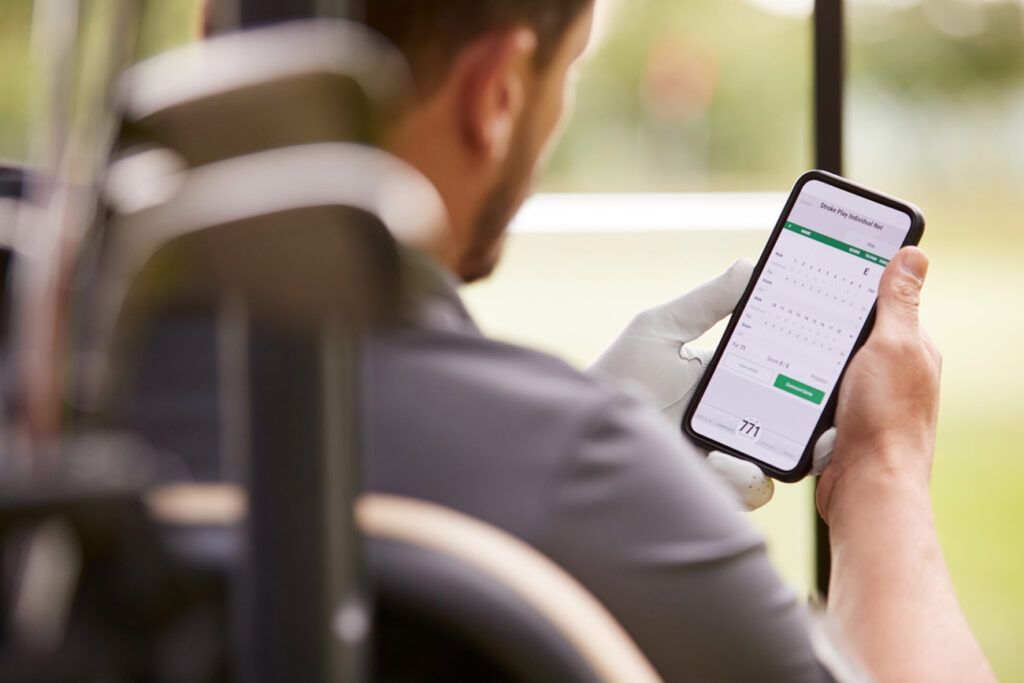Golf professionals, general managers, owners, and golf committees have purchased golf cart GPS systems for well over a decade now. Many golf cart GPS systems require the installation of a GPS screen for the golf cart. While screens in the carts are important for some facilities (some resorts), they are not required for the vast majority of golf courses, and golf clubs. These golf cart GPS systems come at a high cost. Besides, these screens can be a negative for many facilities. Proactively managing operational metrics like wait time and pace of play is more valuable to the business.
Here are 8 reasons why you shouldn’t purchase a golf cart-mounted GPS system.
1 – Golfer Demographics have Shifted
According to the National Golf Foundation (NGF), golf’s 2020 “green grass” growth (i.e. not Topgolf) in participation was led by Youth (+630,000 under 40 years old), Women (+450,000), Non-Caucasians (+320,000), and Under $75k in Income. These demographics suggest that the shift in golf spurred on by COVID is broadening the game’s appeal. Shifts in customer needs, behavior, and expectations have followed.
Younger and more diverse consumers will expect experiences that are enhanced by mobile phone technology. They seek experiences that have less friction and are similar to those offered by other industries that leverage technology advancements. Mobile-first is not a new concept, golf is just further behind.
2 – Everyone has a Screen in their Pocket
According to eMarketer, adults now spend more time on their mobile phones consuming media than they do watching TV. There are 3.5B smart phones and people spend an average of 2:55 minutes a day consuming media.
Take New York City taxicabs as an example. Screens were installed in the back of cabs to facilitate payment (and, to make money on advertising – see reason #8 below). Taxi TV, as it was known, was not received well. “Along with subway delays and bridge tolls, the screens might top the list of city transportation complaints” and they were eventually removed. Undoubtedly Uber and Lyft pushed the taxi industry towards using the screens everyone already has in their pocket.
Food and beverage ordering at golf courses can already take place using mobile phone applications like Club Caddie and Airstryk.
3 – You have Walkers and/or Caddies
Golf cart tracking systems only track carts. If a substantial number of your rounds are walking or caddie rounds, these systems are incomplete and less effective in managing the pace of play and wait times. There are systems that also track walkers through handheld, portable devices that work with your cart GPS system. See here.
It should be noted that tracking players through mobile phone applications is not practical given the constraints placed on mobile phone operating systems developed by Apple and Google.
4 – Cart GPS Screens are Expensive
Systems like Visage, Yamatrak, and Textron Fleet Management which are all offered by cart manufacturers are very expensive. Golf cart GPS systems cost can be great than $50k a year for a fleet of golf carts. See this article from a few years ago. Why pay for more screens? It’s like buying more TVs for your home when your children watch on their computers and phones.
5 – Your Facility is a Private Club
Private Golf Clubs and Country Clubs have a lot of repeat play since you have to be a member (or infrequent guest of a member) – it’s obvious that they are “private.” Many of these Clubs have a profound respect for the tradition of the game and don’t believe screens in golf carts support tradition. Unlike resorts and destination golf courses, members at private Clubs know the golf course well and have their own distance devices.
6 – Your Facility does a lot of Rounds
Managing a large number of rounds is easier when using technology and data to manage your tee time intervals, the pace of play, wait times, and green fees. Optimizing the player experience and pricing is done more easily with systems that specialize in improving golf operations. This has not been the focus of cart GPS systems that prioritize the screen interface in the golf cart. Newer technology companies in golf have taken a different approach and focus on the operational metrics that yield dramatic business results.
7 – You Believe in Enabling Your Staff with Technology
Traditionally, golf courses of all types have used marshals, or rangers, to monitor and improve the flow of play, or pace of play. The conversations they have with players are often a source of friction. They are based on rules of thumb. Importantly, marshals waste time and money driving around the golf course “looking for issues.”
The newer breed of technology solutions provides the necessary data to make improvements proactively. These systems will also save you time and money since the operations team is alerted to when/where there are issues. The advancements made using data to run a golf course operation cannot be underestimated. Traditional tracking systems only track the fundamentals and are not actionable.
8 – Advertising is Disruptive
Companies that provide GPS screens for golf carts have historically justified the expenditure through the offset of advertising revenue. Advertising to golfers during a round is certainly a way for the operator to offset the expense, but it degrades the experience.
Golf is a respite from the everyday daily pressures of life. Players should be left alone, not bothered like this. Advertising can create a negative perception of your golf course brand as well. Besides, it’s ineffective for your advertisers as the timing and context are missing.
Â

Dave Vanslette is a technologist and entrepreneur with over 30 years of experience applying technology to solve business problems. He founded FAIRWAYiQ in 2015 to transform the management of golf courses through data, sensors, and analytics that deliver operational improvements, cost savings, and improved player experience. FAIRWAYiQ has been featured in leading golf and technology publications.

